EBR charges a service fee to manufacturers to produce ebike reviews and videos, this began in 2018. It’s the same flat fee for each bike, and it helps us to keep the site going while limiting ad clutter. We appreciate the opportunity to serve you with our opinions and data but respect your right to know that we receive compensation :)
Electric Bike Outfitters (EBO) is a Denver, Colorado based company that has been in business since 2015. It is now expanding to other states and even ships internationally. EBO kits may have some limitations but the 30-day return policy and one-year warranty is reassuring for a product like this that tends to be priced lower and can be prone to more complications than complete electric bikes. Jason Livingston, the founder, has always struck me as a relaxed and honest guy. I have known him since 2015 when we reviewed some of his first products. He is doing such a good job that many bike stores now carry his kits and perform conversions for customers. I have consistently been impressed by the lengths to which he will go to customize each sale. For the Front Range 2.0 kit, he offers two display types, a trigger, half-grip, or full-grip twist throttle, and hand spoked 20″, 24″, 26″, 28″, 27.5″, 29″ or even fat bike rim! So you can convert recumbents, full-sized city bikes, tandems, trikes, and mountain bikes. You just need to be able to mount the battery pack. Electric Bike Outfitters will even create cables that are longer than normal so you can mount the display, battery, and throttle in the best possible locations. EBO conversion kits are not the most affordable, but they cost less than most purpose-built e-bikes. Their products are flexible and not limited in their application so, even though the Front Range 2.0 kit is ideally suited for off-road mountain biking and climbing applications, it makes a decent cargo kit too. With a peak output of over 1,000 watts and 60 Newton-meters of torque, you’re getting considerably more power than the smaller Burly kits offer, although it takes more space and makes a bit more noise. EBO’s Clydesdale kit has a tougher, quieter gearless motor, but I noticed some cogging, or magnetic drag, that you don’t get with this one. The mid-drive positions all weight at the middle of the frame but increases wear on your chain, sprockets, and derailleur and just isn’t as powerful as the Mountaineer.
The Front Range kit only comes in black but, it tends to blend in and matches the cables, battery pack, and black rim. The settings allow you to lower the top speed, make the throttle active in assist level zero so you can ride like a scooter, and enable cruise control to give your wrist a break! This kit can be adjusted to go faster and can be used as a Class 3 speed pedelec, up to ~28 mph, or as a Class 4 off-road product even higher. I like that Jason has personally edited and clarified the online manual so you can confidently experiment with the many options that are available. You can even call EBO with any questions that aren’t addressed in the manual. In short, I think this kit will appeal mainly to people who are looking to get more power and ride a bit faster on trails and up steeper inclines, but it’s also capable of carrying some extra weight. If you’re looking for more power and torque, whether for hill climbing, taking your child for a ride, or rugged off-road use, this kit provides that boost. And with a range of up to 55 miles from one charge and a unique cruise control feature, this kit is well-suited for extended commuting, too. The EBO 48V Front Range kit is lighter than the Clydesdale, but possibly more vulnerable and not quite as bulletproof. It’s heavier than other products in his line (like the Burly kits) but it is more powerful in terms of torque. I’m a pretty active rider, so I am definitely partial to the nimble feel of smaller geared hub motors. And, as is the case with the EBO Burly kits, I prefer the lower battery mount position to the rack mounted kits such as the EBO Cruiser. In reality, it seems that EBO offers either battery configuration for all of their motors, so it’s more about where you want the weight or have space on your frame.
The Front Range 2.0 features a motor with planetary gearing, so it’s compact and zippy compared with a gearless hub motor. The motor is built onto a 12 mm threaded axle with 9.8 mm flat cuts on each side, which fit into dropouts and push against the frame as the motor turns. By default, the kit does not come with an external torque arm to spread the force of the motor but you can pay a bit extra if you do want a torque arm because of softer or failing dropouts on your specific bike. The left side of the casing has threaded eyelets for mounting a disc brake rotor, but the rim also has machined sidewalls so it is compatible with linear pull caliper brakes in addition to disc brakes. EBO spokes their motors into each rim by hand using thick 12 gauge spokes for extra strength and durability. Jason opened one of the motors so we could take a look at the copper winding and planetary gearing inside. The gears are plastic, which is not uncommon for motors like this. I have found that it is still very durable but also quiet and lighter than steel or aluminum gearing (it weighs ~8.7 pounds total). The motor ramps up smoothly when taking off and freewheels efficiently when coasting. This kit is only available for rear wheel mounting since it can only be mounted to a wheel with a 135 mm hub spacing. Because many bikes have rear derailleurs and disc brakes with extra cables for shifting and braking, installing a motor there can be considerably more difficult and cluttered than putting it on the front. But, rear wheel mounting makes sense because it provides more traction (as weight shifts back during acceleration) and makes steering quicker and easier. A rear wheel setup will also have at least one sprocket and, to replace your existing hardware, the EBO Front Range 2.0 kit can be configured with either single speed, Shimano 6 or 7 speed cassettes, or SunRace 8 and 9 speed cassettes. This kit is compatible with multiple chainrings so you could end up with a 21 or 24 speed, great for climbing. If you currently have a quick release wheel setup, the Front Range will replace it with the solid threaded axle and nuts. EBO uses durable Julet cables with water-resistant connectors, but it’s worth noting that there is one additional cable protruding from the right axle and this is something to be very careful with. I would avoid letting the bike tip over, as you might bend this cable. And I would watch for snags on foliage or rocks as you ride. It’s a vulnerable point for most hub motor powered e-bikes! The reassuring benefit of this drive system, however, is that it completely separates pedaling from the motor. That means a lot less wear on the chain, sprockets, and derailleur, compared to a mid-drive system.
A lithium-ion battery pack powers this kit. It’s made with Samsung 18650 cells configured as 13 in series and 4 in parallel to offer 48 volts and 11.6 amp hours (though Jason advertises 11 to set expectations more realistically). Hub motor powered e-bikes are zippy and have a fun feel to them, but they operate less efficiently than most mid-drives. They work easily with throttles, don’t require a custom frame design to interface, and aren’t as vulnerable to rock strikes (as a mid-drive with lower ground clearance might). The battery pack itself is reasonably lightweight at ~7 lbs, and it interfaces with a plastic slide which will need to be screwed onto the frame. There is a sturdy metal track inside the plastic slide, with long slots for inserting bolts. In most cases it can be mounted to bottle cage bosses on your downtube, like you see on the Yuba Mundo cargo bike in the video above. This configuration positions the battery weight low and center while protecting the casing from getting kicked as you mount (unless you have a step-thru frame or opt for the rear rack battery). Lithium-ion cells are durable, lightweight, and long lasting. Although they are heat and cold sensitive, they don’t develop a memory if you don’t charge them immediately. I’ve heard that if you let the pack drain below 20%, there’s a chemical change in the cells that could stress them and reduce the overall lifespan. It’s best to store the battery pack in a cool, dry location, and you can charge it either on the frame or off. It locks securely to the frame but has a hinged handle on top for easy and secure lifting. One of the issues I have with this battery pack is that the slide mount only attaches with two bolts in most cases. Compared to purpose-built e-bikes, it’s just not as sturdy or nice looking (newer bikes have batteries that are sunk into the downtube a bit for even lower weight and sturdier positioning like this). The EBO Dolphin style battery pack may not fit on some youth, folding, or step-thru frames (and for that, EBO has the rear-rack battery option). There is a fuse, charging point, and USB port, all on the right side of the battery, but the USB port is disabled to reduce phantom draw (which might otherwise drain it below the 20% point during long periods of disuse). I actually tend to check on my battery every month or so when I haven’t been riding. I found it challenging to seat the rubber charge port cover properly. I had to be intentional about lining it up exactly before pushing in with some force. The battery charger provides 2 Amps of power output for regular charging speeds. It’s not the most compact or lightweight (~1.9 lbs), but it’s small enough to carry in a bag while you ride. Now one last complaint about the battery pack is that it has to be turned on separately from the display panel, and this takes a few extra seconds. The extra time isn’t really a big problem, but some riders might forget to turn it off after each ride and this could cause the pack to drain slowly. This issue is not unique to EBO kits, or even purpose built electric bikes, but it’s worth mentioning.
So let’s imagine that you’ve charged the battery, mounted and locked it to the frame; you turn it on by pressing the silver circular button on the left side (which has a blue LED glow once activated). Finally, you turn on the control pad by holding down the power button for a couple of seconds and your LCD screen (or LED console) comes to life! The default display hardware is a beautifully backlit LCD with integrated USB charging port, but EBO does offer to swap it for a basic LED console to reduce handlebar clutter and limit the fancy look of the kit (which could attract unwanted attention in some situations). As much as I like both of these displays, I do find them to be somewhat vulnerable, which could be a drawback for mountain bikers and off-road enthusiasts. The LED pad is nice because it shows a speedometer in addition to the current charge level and assist mode. Neither one of these two display panels is removable, but both can be swiveled a bit to improve readability or reduce glare. The LCD has all sorts of menus, but is operated by just three buttons on a remote button pad within reach of the left grip. This control system combines simplicity with depth and is intuitive to use. Once you get used to it, you won’t need to keep looking down at the display. The power button in the center of the remote button pad allows you to cycle through trip stats like odometer, trip distance, average speed, max speed etc. and the up and down arrows allow you to raise or lower the assist setting. By default, the bike is set to assist level zero, so that the throttle is inactive. Once you arrow up to 1-5, the pedal assist sensor goes live and you can instantly use the throttle with full power. Again, it ramps up smoothly and feels a bit more refined than some other systems I have tried. I prefer to pedal with an efficient, lower level of pedal assist, with occasional bursts of power to catch up with friends or climb hills, and this system lets me do that. Whether you’re riding at night or in bright sunlight, the LCD should be viewable, because you can hold the up arrow to activate backlighting. And if the bike is moving slower than 6 mph, holding the down arrow activates walk mode. The menu features a lot of fun settings to explore, including lower top speeds and cruise control, and the cadence sensor can be adjusted for more or less sensitivity to suit individual preferences. EBO’s cadence disc uses eight magnets (unlike some other kits out there that have 12). Jason assured me that eight is enough to make it responsive because the disc is smaller, which also makes it less likely to be bumped. He explained that some people may want to lower the sensitivity because an accidental partial pedal stroke could unexpectedly engage the motor. That sounded reasonable and my experience during the ride tests felt pretty responsive. Unfortunately, the cadence sensor is one of the more difficult parts of this kit to install; it requires a bottom bracket wrench since you have to take off the crank and slip the the sensor and magnetic disc over the spindle. A lot of us would need some help from a shop to get it on. While it’s not a quick and easy clip-on design, the long-term benefit is that it should be more stable and reliable. In short, I appreciate how the display that comes with this kit is so useful and that this bike can be customized to perform as you prefer. It’s not limited or locked up like most purpose built ebikes; it gives you USB power for maintaining a phone or other device while you ride. My biggest complaint is that the display just seems a bit vulnerable for rugged mountain biking and off-road use.
To sum up, the Front Range 2.0 kit is yet another great option for electrifying your bike. It gives you EBO’s proven hardware: the geared hub motor, the cadence sensor, the water resistant Julet connectors and, while it’s not super fancy, you still get a whole lot of functional options to explore. Yes, there are going to be extra wires strewn about your frame, and yes it does cost more money than some generic kits, but the company has been around for a while and seems to offer generous support. This kit is probably ideal for light trail riding and moderate climbing, but will appeal to people who want to ride a bit faster or have more weight to move around too (body weight, cargo, or a heavier bike). You can unlock this kit to get up to nearly 30 mph. In that case, your bike would be limited to private property and off-road uses, but you could also remove the throttle and set the the top speed to 20 mph for class 1, add the throttle back for class 2, or remove the throttle and set the maximum speed to 28 mph to achieve class 3. That makes this one of those kits that is great for commuters, mountain bikers, tandem riders, cargo haulers, and just about anything else you can think of. Though a lot of other cadence sensors can have a jerky, on/off feel to them, this motor ramps up smoothly (you can see this in action in the video). The control systems are intuitive, but deeper than normal, and not locked. You can coast with ease since there is no cogging or reduction gearing at the bottom bracket. And, with a relatively lightweight setup (around 17 lbs total) you can still pedal smoothly when the motor is off, or remove the battery to ride almost like a normal bicycle (plus about 8 lbs in the rear hub). A cool thing about the battery is that it can be daisy-chained with other batteries to give you more range. During this visit to EBO, I saw a cool setup on a recumbent trike with two batteries being built with the 48 volt Burly kit and I believe that it would work here too. I find the 500 to 1,000 watt output of this kit very satisfying and capable of the kind of performance it aims to provide. I can see how this would give you a nice boost for mountain biking up difficult hills or to give your legs a break on a long commute. With bicycles, the trade-off is usually between cost, weight, and performance, so all three should be taken into consideration before deciding on a final purchase. The idea is to find a kit that will offer enough power, fit your budget, and position the weight well while also looking good on your bike. That being said, EBO makes some of my favorite kits because of how much customization they offer, and I trust Jason. I would like to give Jason a shout out for partnering with me on this and other EBO reviews. It’s been nice to keep track of what EBO has been working on since 2015. They seem to be expanding in a way that is sustainable and I love that his support is still above average for manufacturers of ebike kits. It’s one of the reasons for the higher pricing, and it’s also what makes dealer sales possible. A few e-bike shops in the Denver area carry his kits now and offer them as an alternative to purpose built products. After all, there’s something gratifying about recycling an existing bike, breathing new life into an old favorite, or building a uniquely custom setup.
Pros:
- EBO has been in business since 2015, they offer a generous 30-day return policy with a one year warranty, and they ship worldwide… I trust them a lot more than some of the generic kits found on Ebay
- Whether you’ve got a recumbent, kids bike, folding bike, city bike, or mountain bike, it seems like Electric Bike Outfitters can build a wheel to fit your bike because they spoke in-house and build to order
- EBO uses nicer parts on their rims and thicker spokes to handle the additional forces of a hub motor, their new Julet connectors are water tight and color-coded for easier assembly and repair
- Safety is a big focus for me, so I appreciate the more sensitive cadence sensor, adjustable top speed settings, different throttle options (trigger, half-twist, and full-twist) as well as the brake lever motor inhibitors
- This kit can be set up as a Class 1, 2, 3, or for off-road applications
- If your bike uses hydraulic brakes, EBO does have an optional sensor and magnet unit that can be screwed and glued on to enable motor inhibiting, but it’s not as elegant or simple as the stock mechanical brake levers, though it’s a nice option to have
- The top speed can be adjusted to determine how quickly the cadence sensor responds, choose from half-grip, full-grip, or trigger throttle
- With a peak output of 1,056 watts, the motor offers a lot of power for a relatively affordable price
- The display panel is large, easy to read, full of interesting settings to experiment with (and EBO has a nice manual to help you do so on their website), and it has an integrated USB charging port, though the display cannot be easily removed for protection at public bike racks or wet days
- Even if EBO eventually goes out of business or changes some of their kit hardware, you should still be able to get parts and have your battery case re-packed because they are not software locked and follow an open industry-standard vs. being proprietary
- Given that the battery pack weighs ~7.1 lbs, it’s great that there’s a handle built into the top, so you can carry it more securely, I suggest storing it in a cool dry location and avoiding extreme heat and cold
- On the one hand, installing the hard-mounted cadence sensor takes more time and tools than one that is glued or zip-tied on, but on the other hand, it is going to be more secure this way, and I found that it worked very well during the ride tests
- Because the battery is tough and the whole system tends to be reliable, it’s one of the more popular options that EBO sells because it positions battery weight low and centered on the frame for improved handling and stability
- Being able to transform an existing bike into electric with multiple drive modes and higher speeds like this for just over $1.4k seems pretty good to me; there are cheaper kits out there, but most of them don’t offer this level of performance or support
- For those who want a really compact display, or just less flashy hardware on their e-bike, EBO offers a black LED control pad with integrated buttons (shown in the pictures above), and I like this thing because it also has a basic speedometer! most other LED control pads only show your battery charge level and assist
- Before shipping each battery, the team at Electric Bike Outfitters actually drains and refills it to test all of the cells, I was told that they experience a 1% failure rate and by testing like this, it saves you time and hassle as the end consumer
- The actual motor casing has been custom designed by Jason, the founder of EBO, and he made it fit on a wider number forks; it works with linear pull brakes or disc brakes (you can mount disc brake rotors directly to the side of the hub casing)
- Hub motor ebikes can often have more pedal gears to work with than mid-motors (because they can easily support multiple front chainrings), and shifting gears causes less wear because the motor power output is separate from the pedaling drivetrain
- Excellent customer service with a 30-day return policy and 1-year warranty
Cons:
- The motor on this kit weighs a bit more and is a bit louder than some of the other EBO kits, but it offers significantly more power and freewheels efficiently (compared to the gearless hub motor Clydesdale model)
- Kits require more work to install and can clutter a bike with parts and wires, but they are a good option for someone who is not quite ready to purchase a purpose built electric bike and maybe wants to recycle an existing bike
- Only available for rear wheel (135mm hub spacing), but it can be used with a lot of different wheel sizes (20″, 24″, 26″, 27.5″ 28″, 29″)
- Display pad is not removable, but has has a USB charging port, allowing it to be used as a power source for maintaining a smartphone or gps electronic device on the go
- The external controller takes more space on the frame and has more wires exposed than the smaller Burly kits that have battery-integrated controllers
- The battery charger is a bit basic, only offering a standard 2 amp power output, and it’s not super compact or lightweight at ~1.9 lbs… still, it should fit into your backpack or other bags easily for charging on the go
- Unlike a purpose-built electric bike, kits usually have extra wires that aren’t as hidden or neat looking; the battery mount slide connects to the downtube with two bolts vs. three or some even sturdier custom designs
- The 8-magnet cadence sensor worked pretty well, and can be adjusted for sensitivity in the settings area of the display, but it simply isn’t as fluid or dynamic as a torque sensor or multi-sensor, there’s a bit of lag starting and stopping
- Geared hub motors tend to produce more buzzing noise than gearless, especially when running at higher power; this one is about average but you can always get the lower powered 36V Burly kit if you want to be stealthier
- The little rubber cap that protects the charging port on the right side of the battery can sometimes be difficult to seat; it’s a minor annoyance but something worth fiddling with each time to protect from dust and water
- Installing a kit like this will take a bit of time, energy, and possibly additional tools like a crankset puller and bottom bracket wrench; you might even want to get your local ebike shop to help you but that adds to the price
- This isn’t a big complaint, but the USB charging port on the battery pack has been disabled (to reduce phantom power draw over long periods of disuse); there’s a second USB port on the lower right side of the LCD display panel that is active, but sometimes it’s nice to use the battery itself as a backup power source off the bike and you simply cannot here
- Most hub motors have the power cable entering into the axle from one side, and this can be a point of vulnerability if the bike tips or you ride close to obstacles that could snag or scrape it; a few of the new Dapu motors have their power cables tucked very closely (behind the disc brake rotor) but I don’t think that you can order them aftermarket as kits
- Turning this bike on and off requires two steps, which adds a bit of time; you first have to power on the battery pack itself and then press the power button on the control pad – just remember to turn it all off before dismounting, transporting, and storing to prevent accidental activation!
Resources:
- Official Site: http://www.electricbikeoutfitters.com/ebo-frontrange.aspx
- More Pictures: https://photos.app.goo.gl/I16cbUlO24gP43hq1

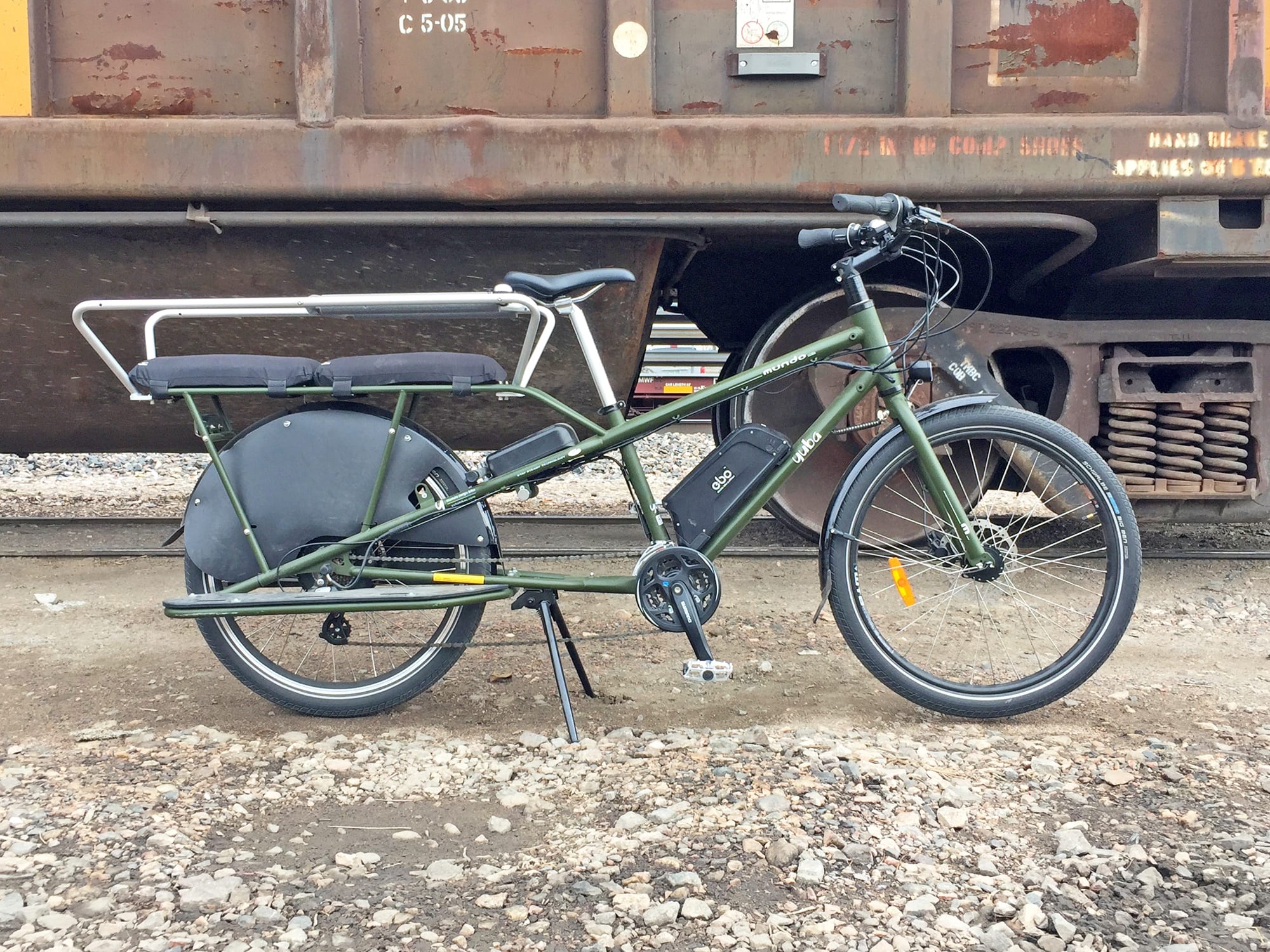
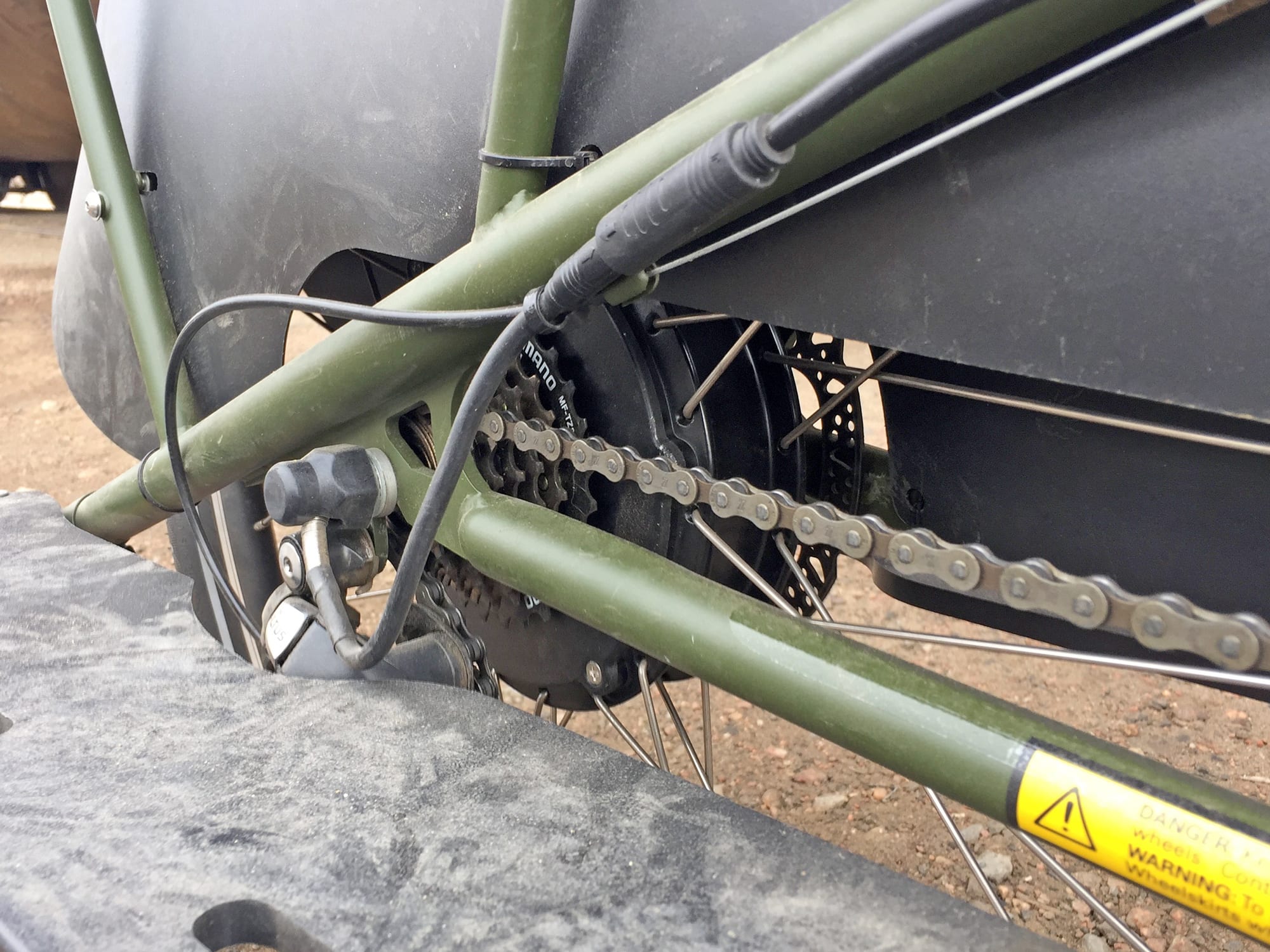
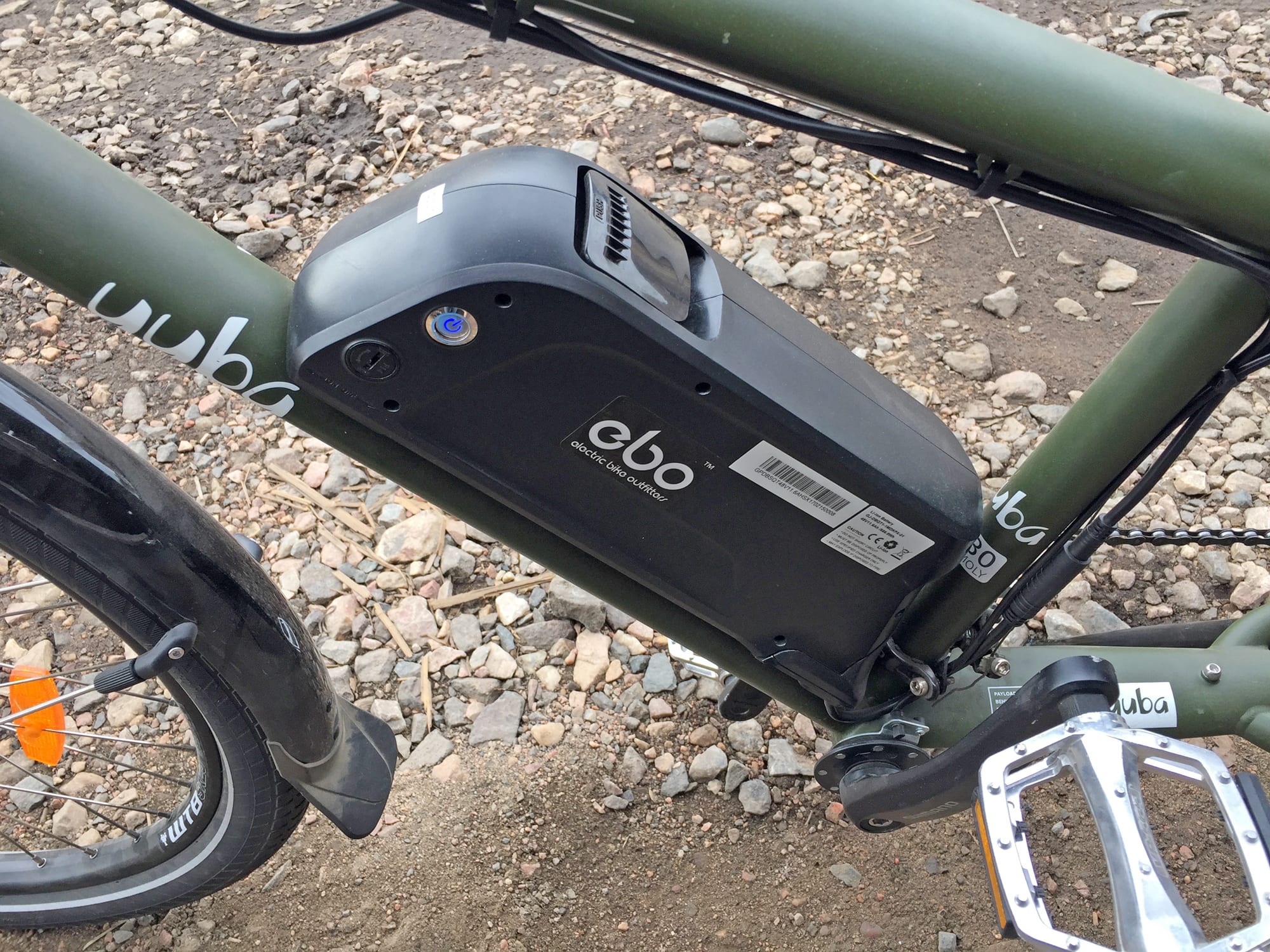
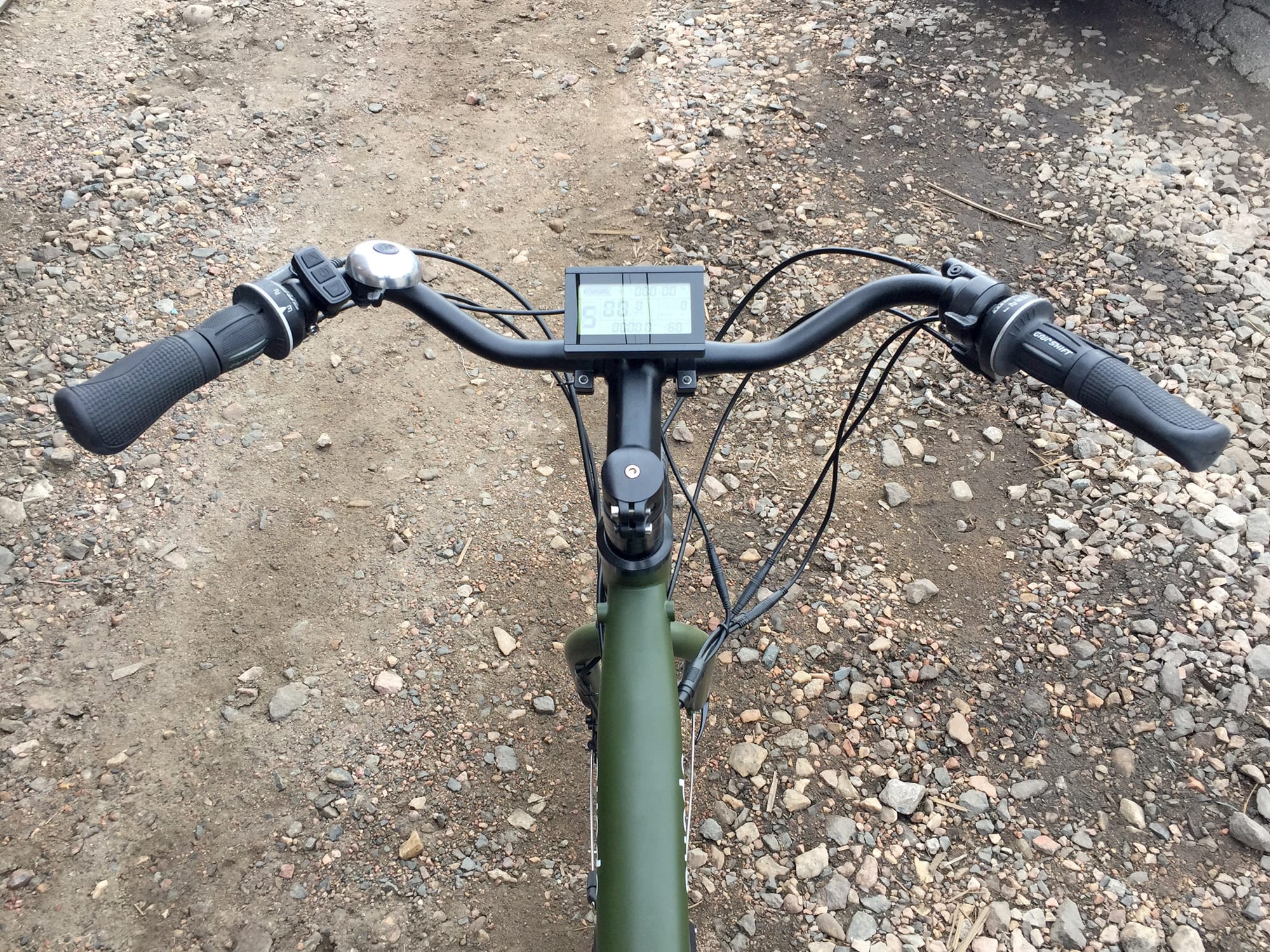
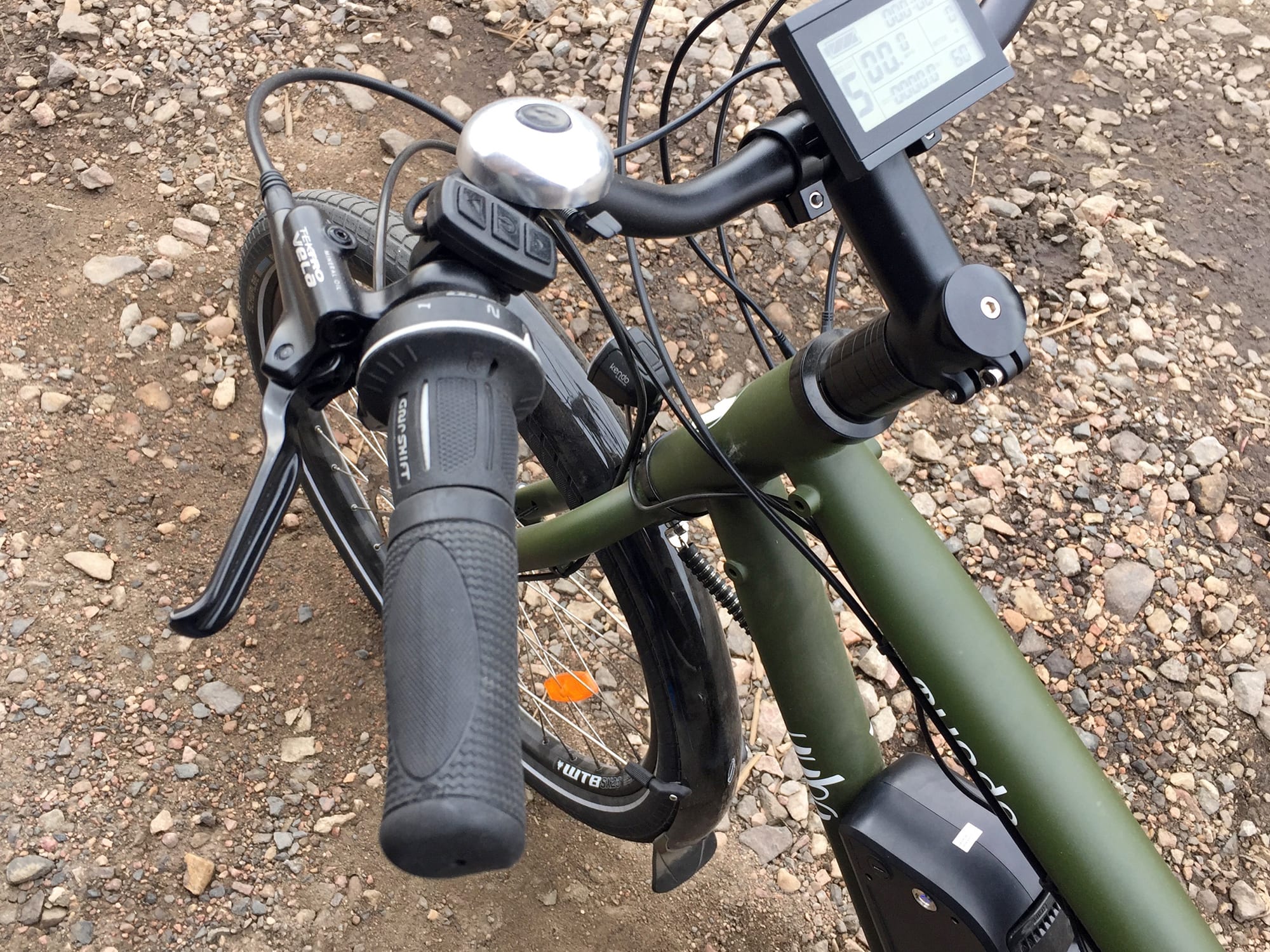
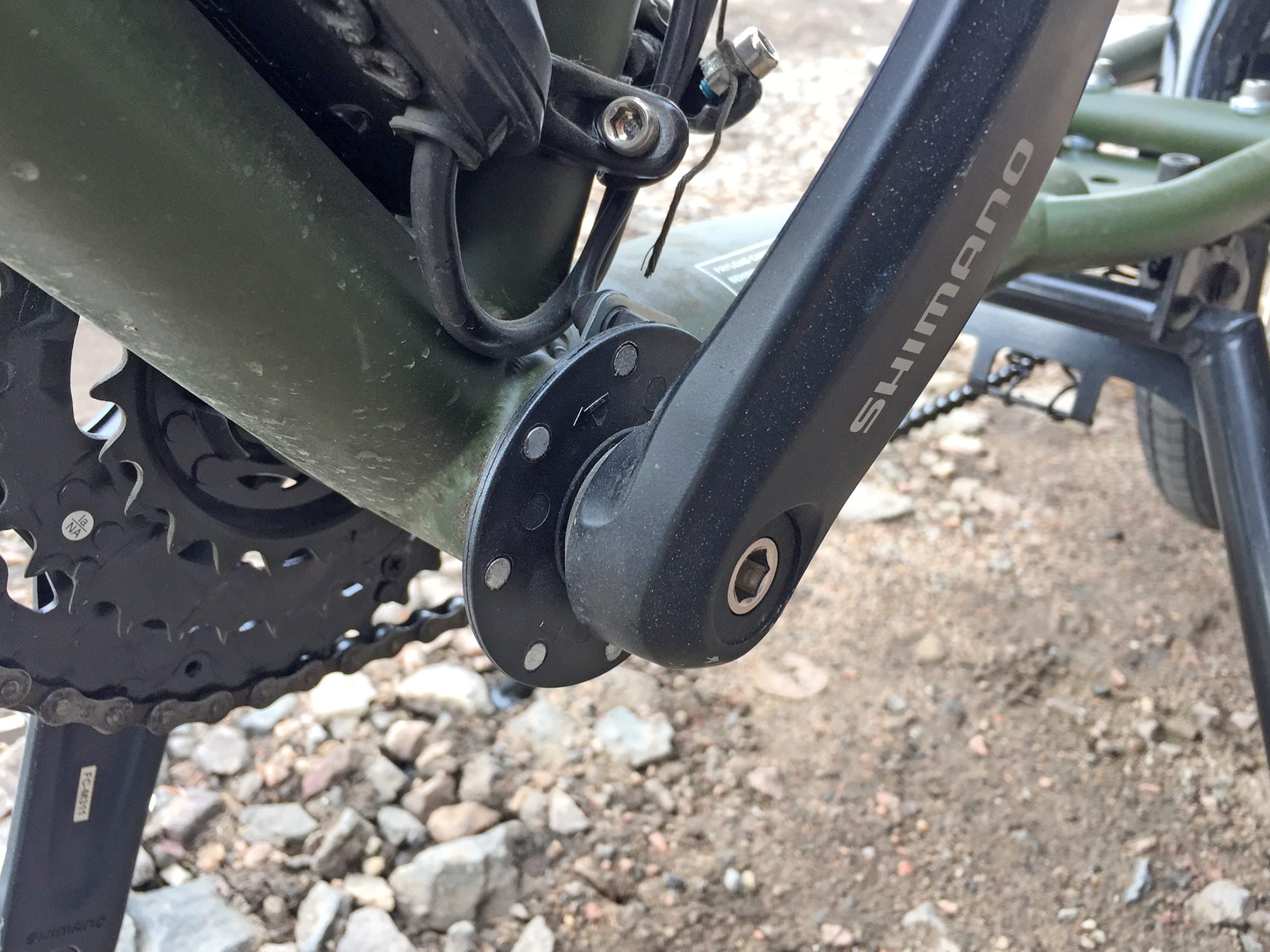
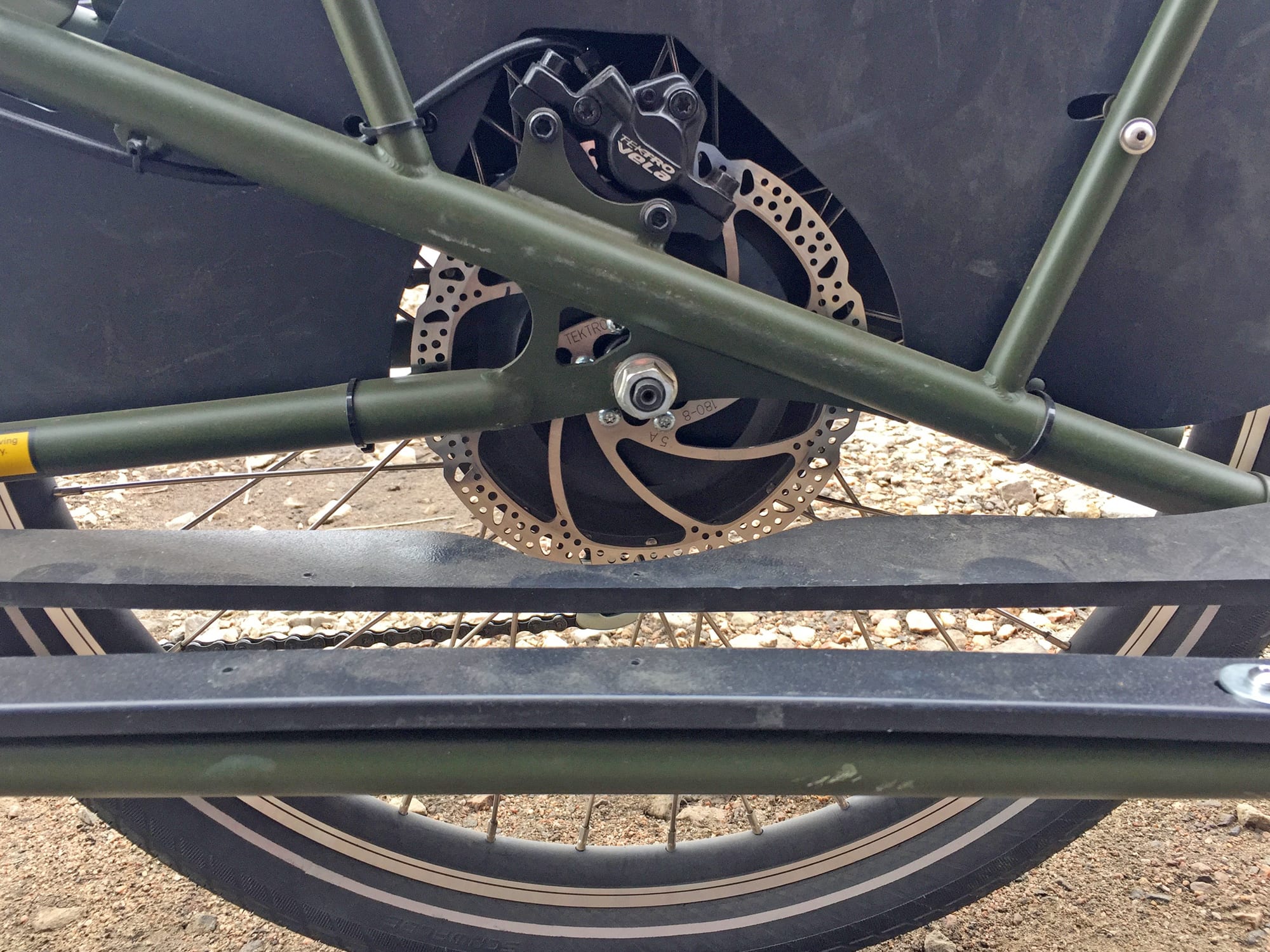
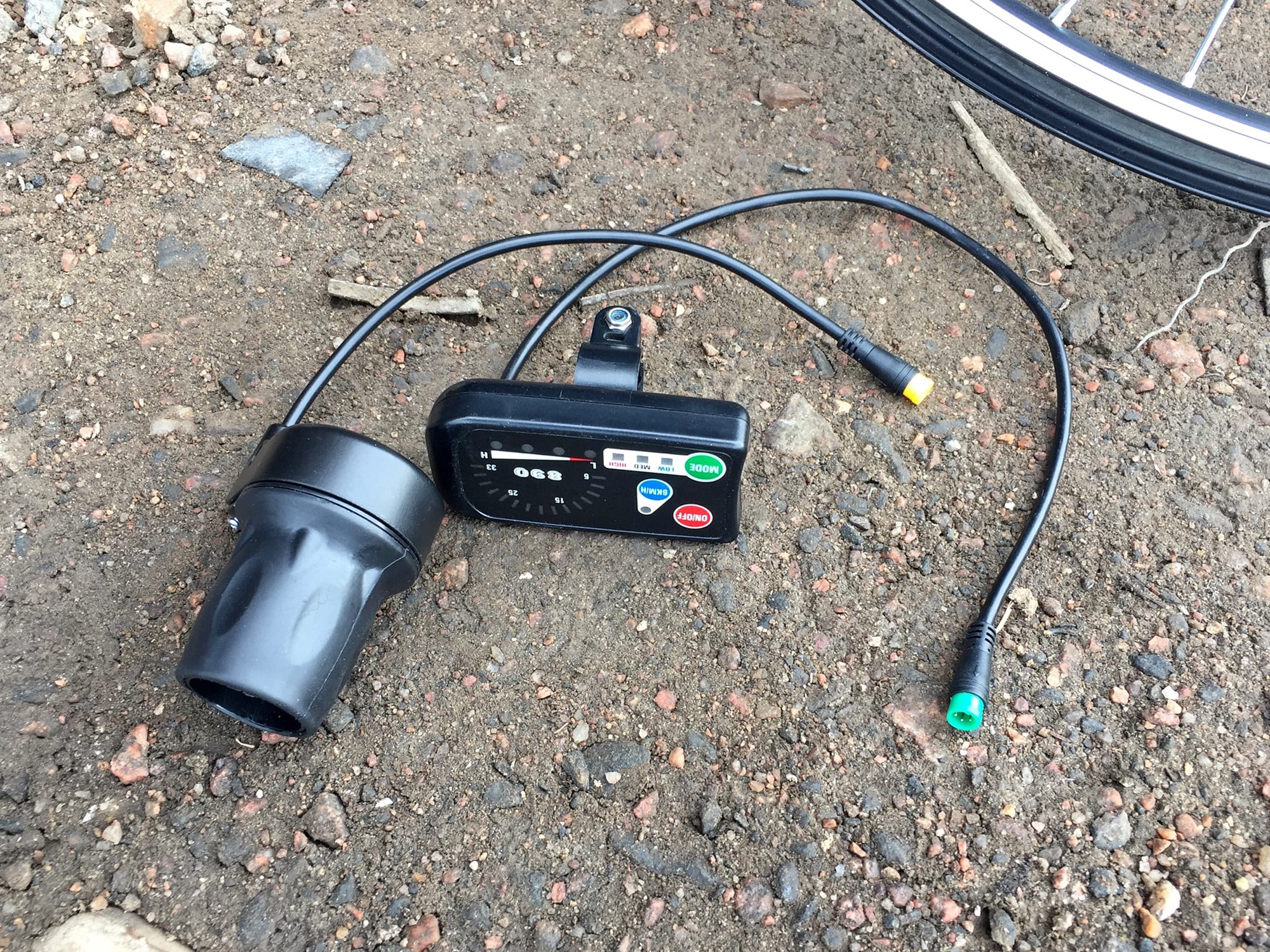
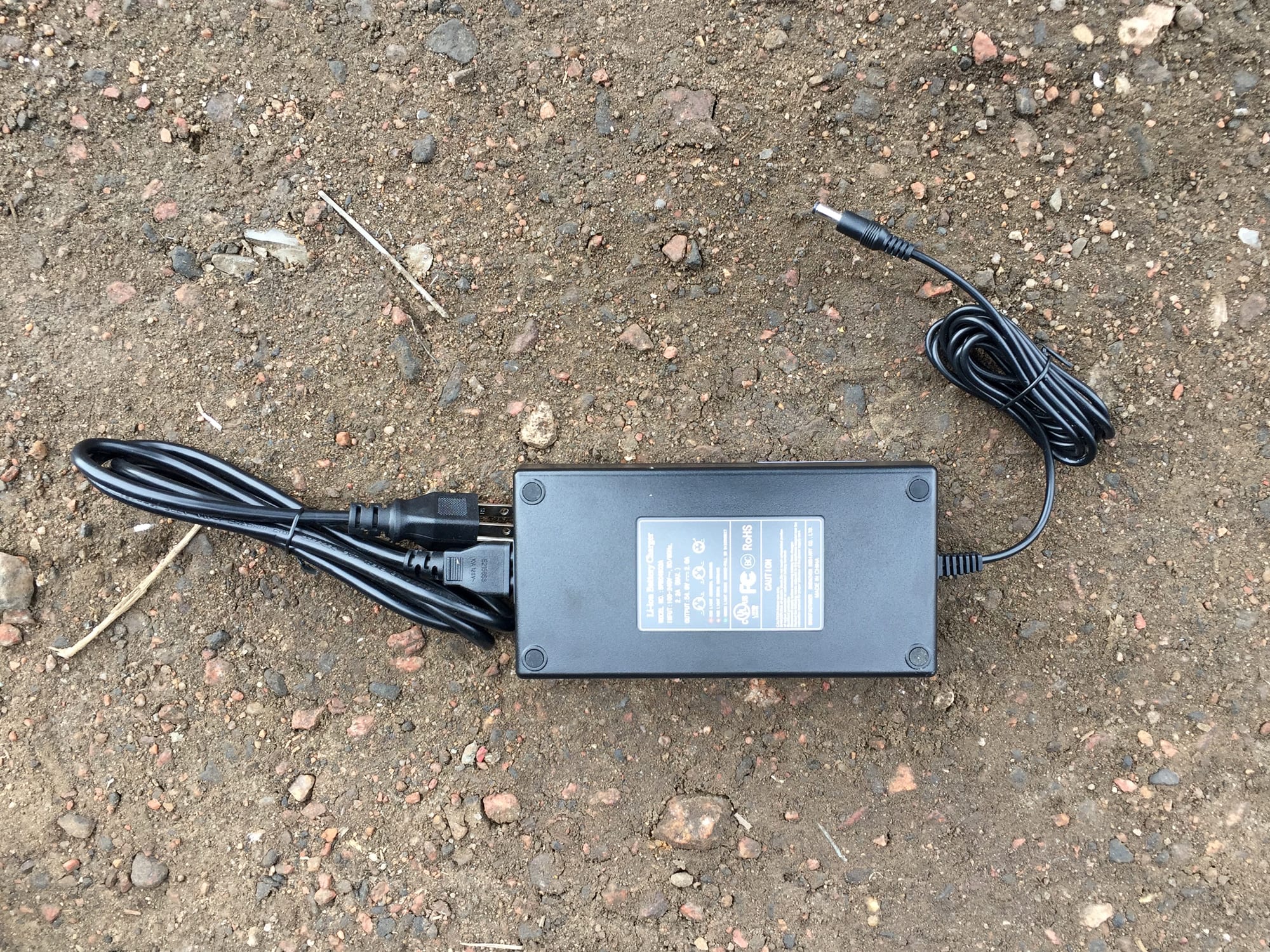
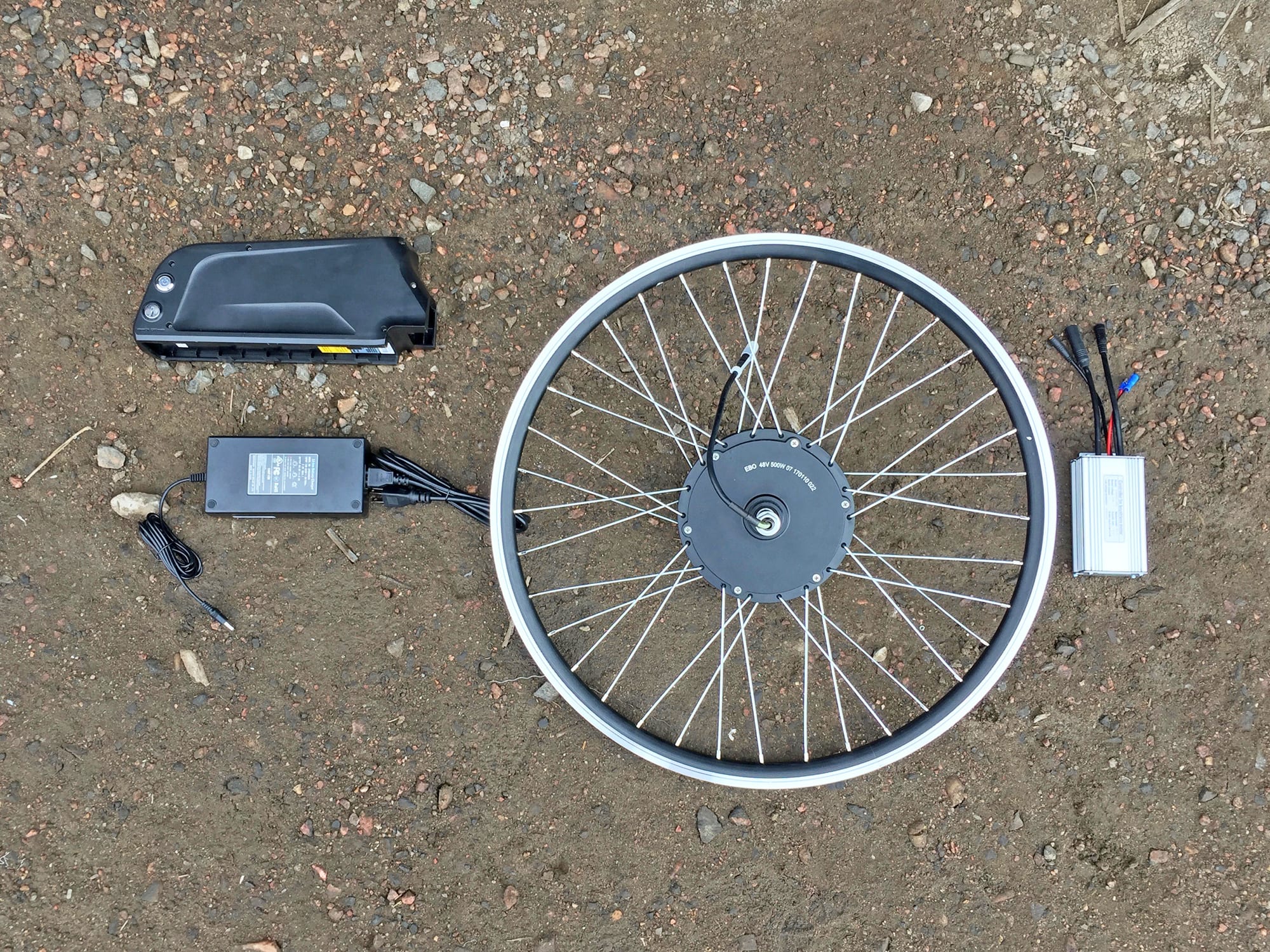

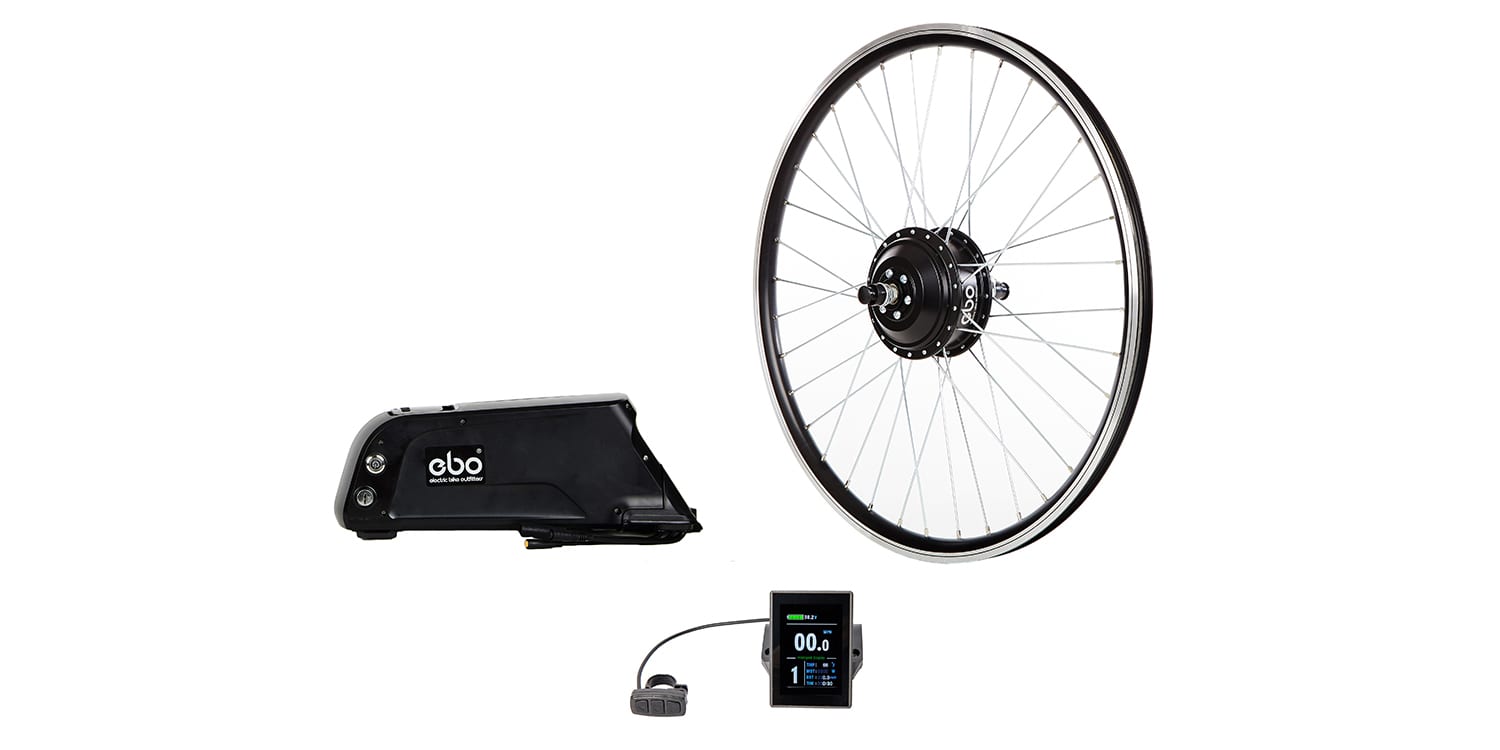
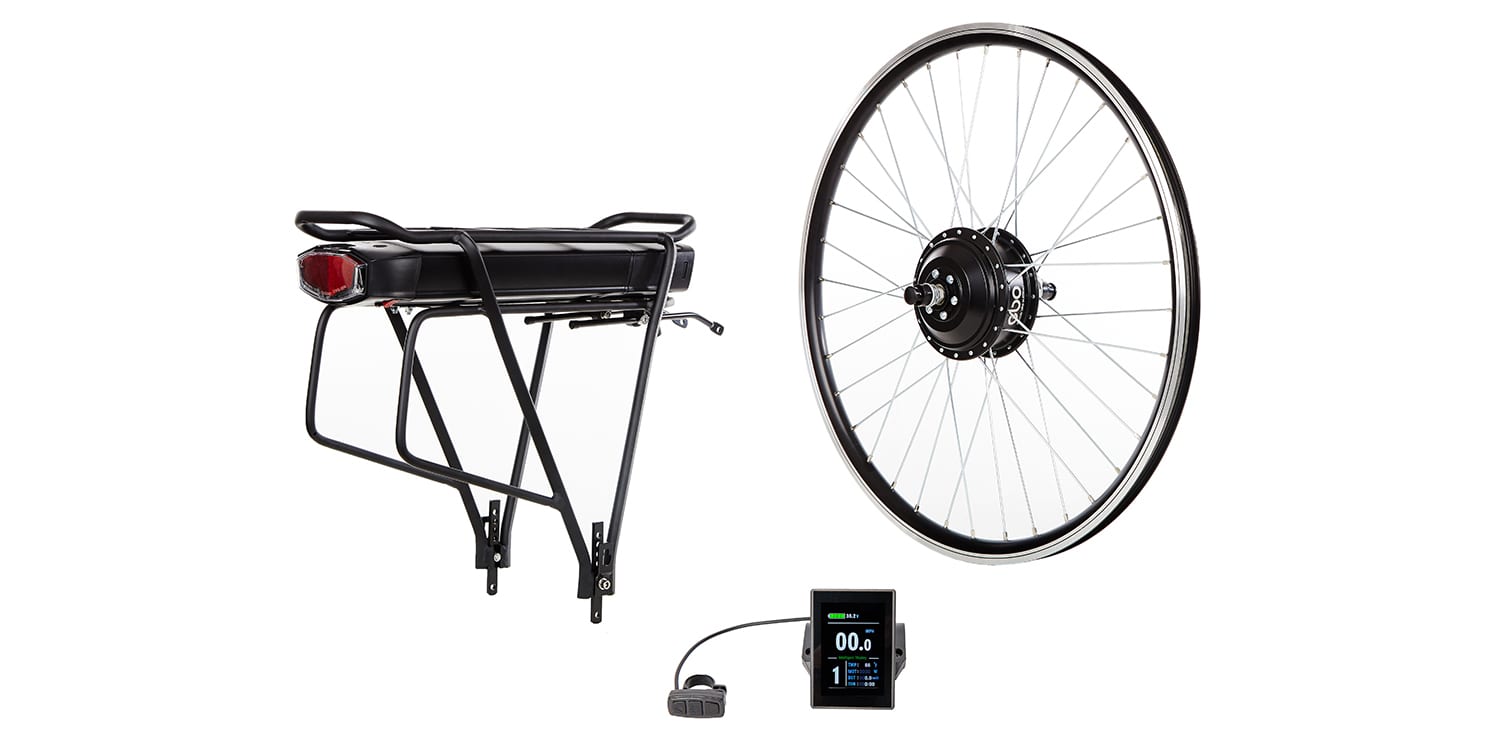

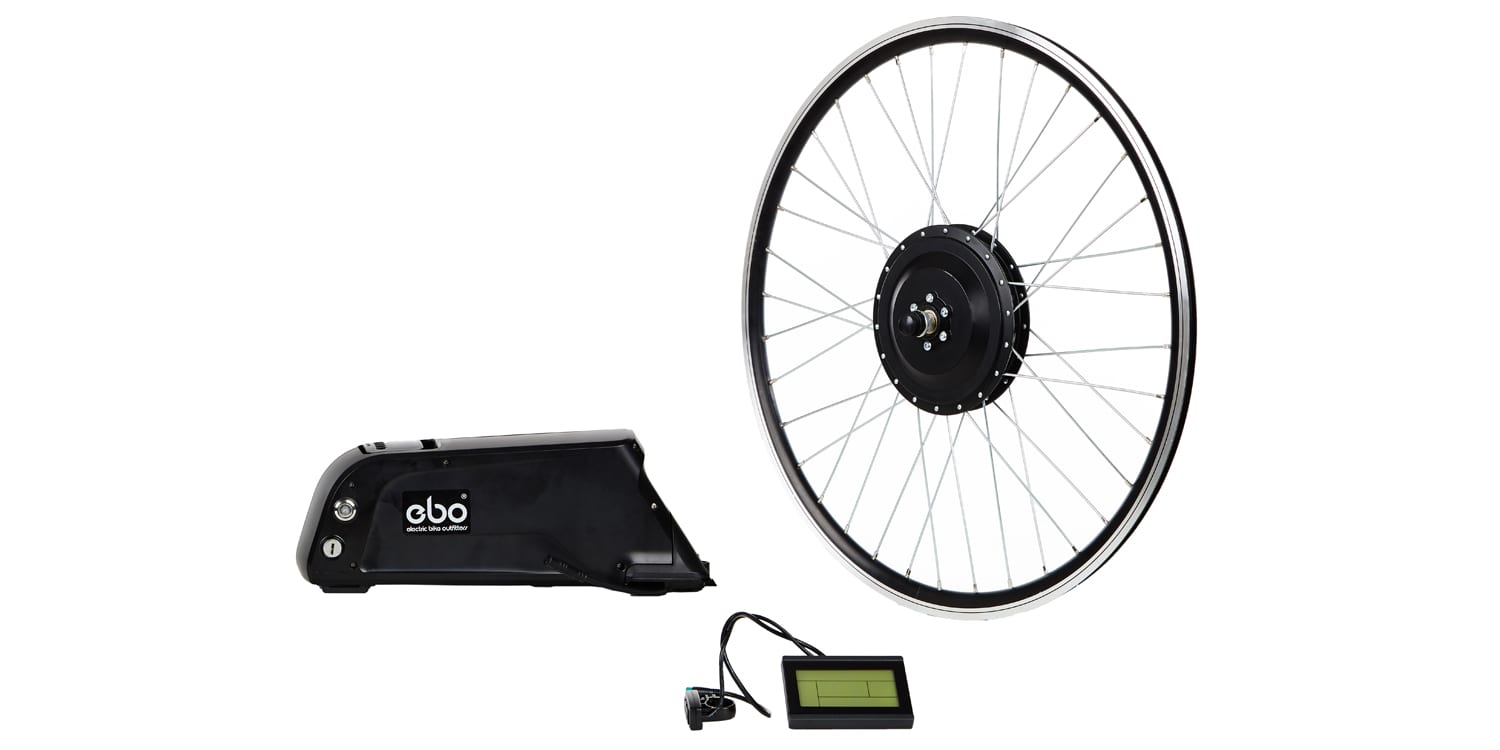
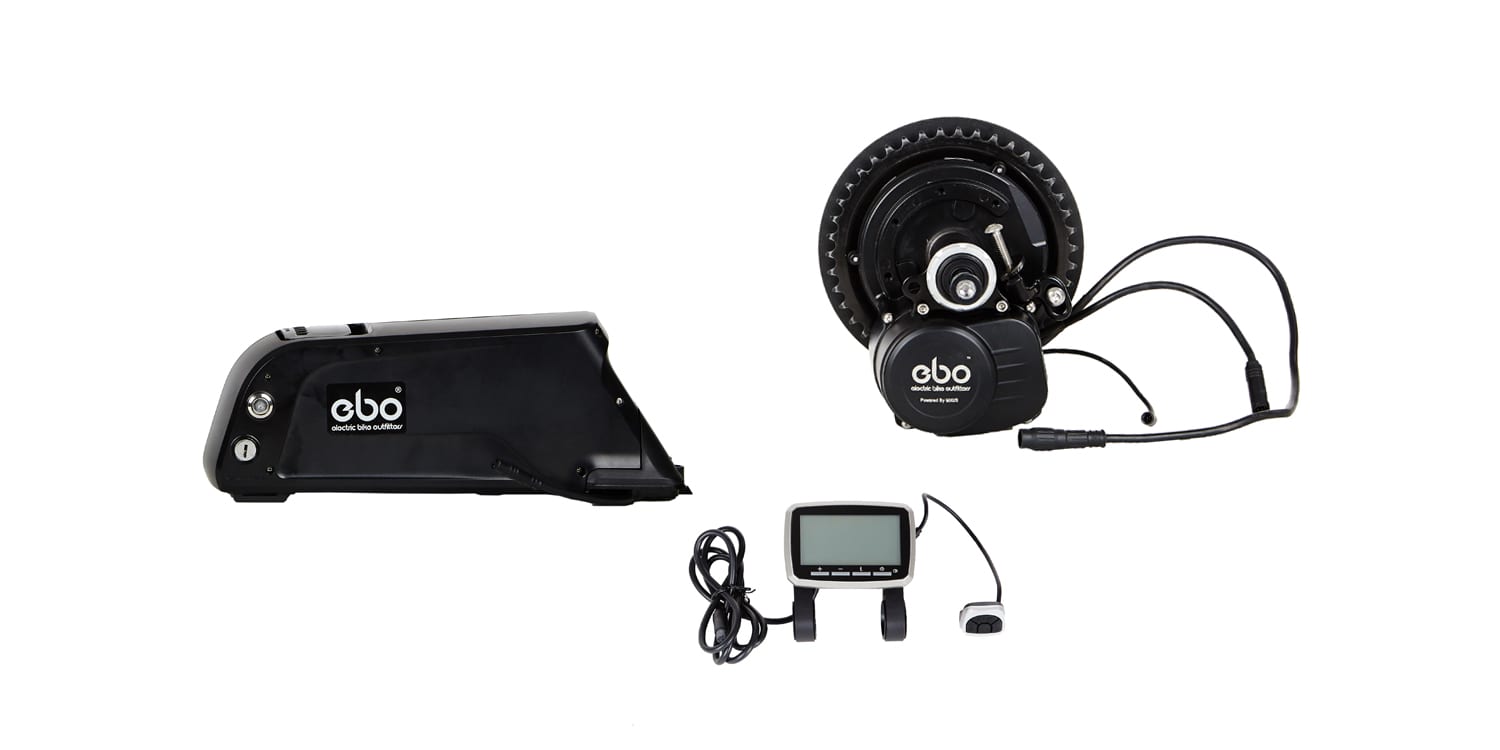
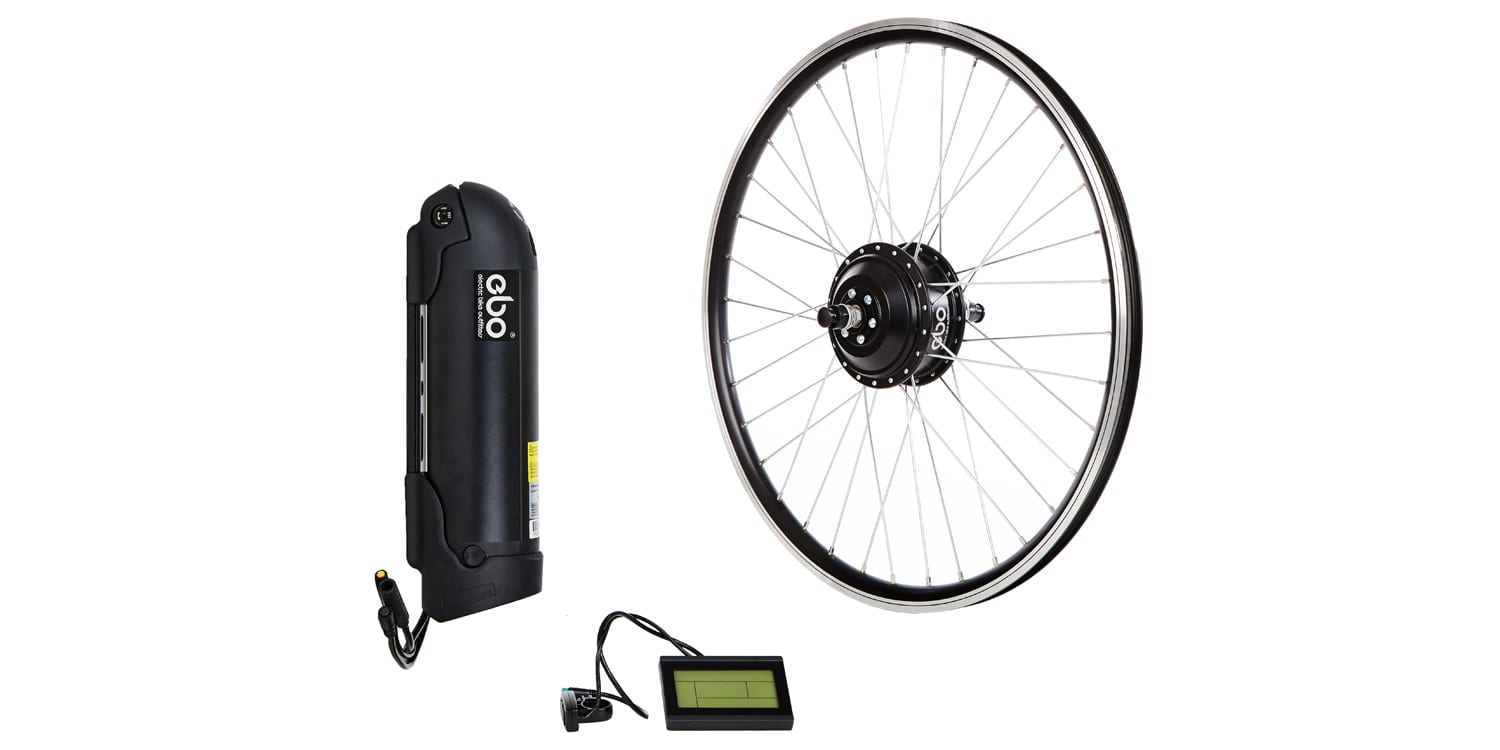
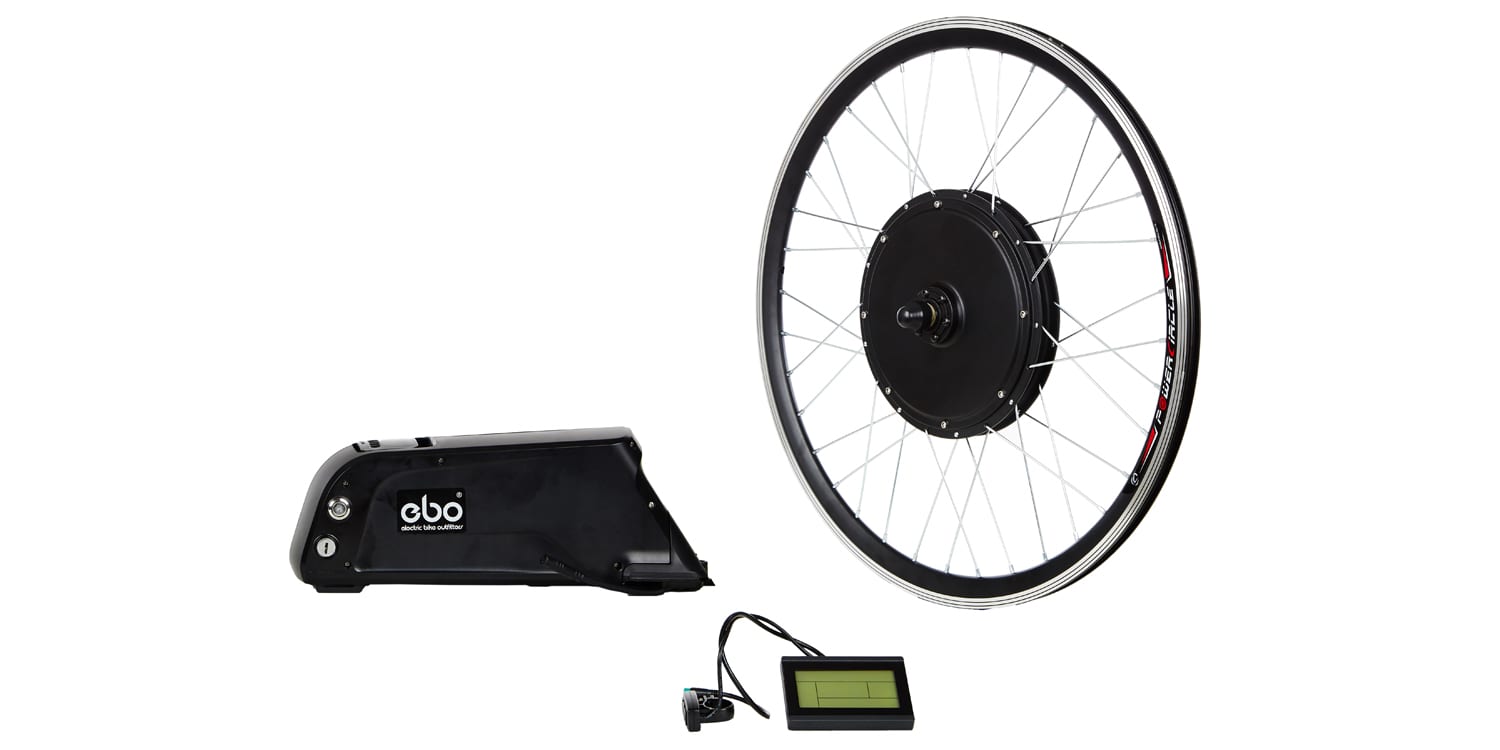
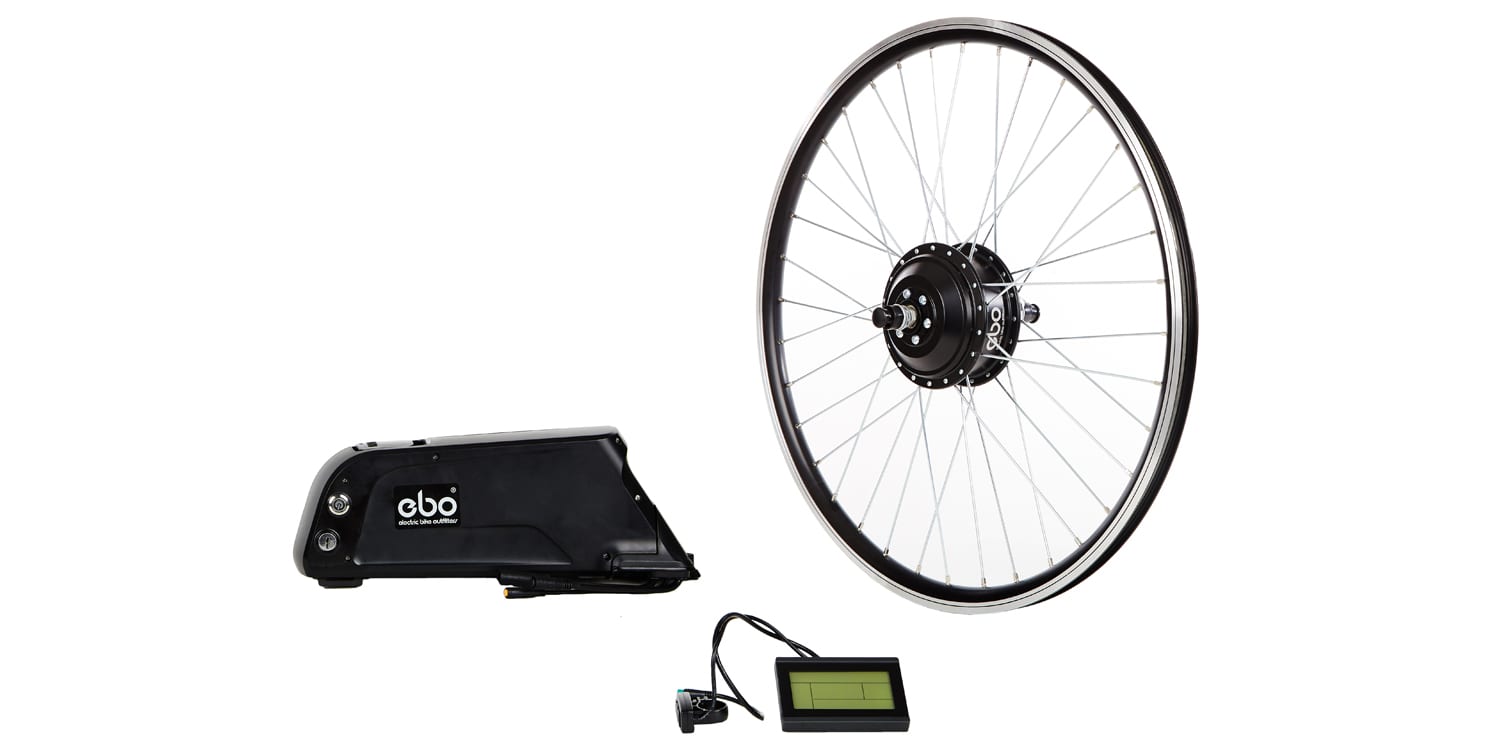
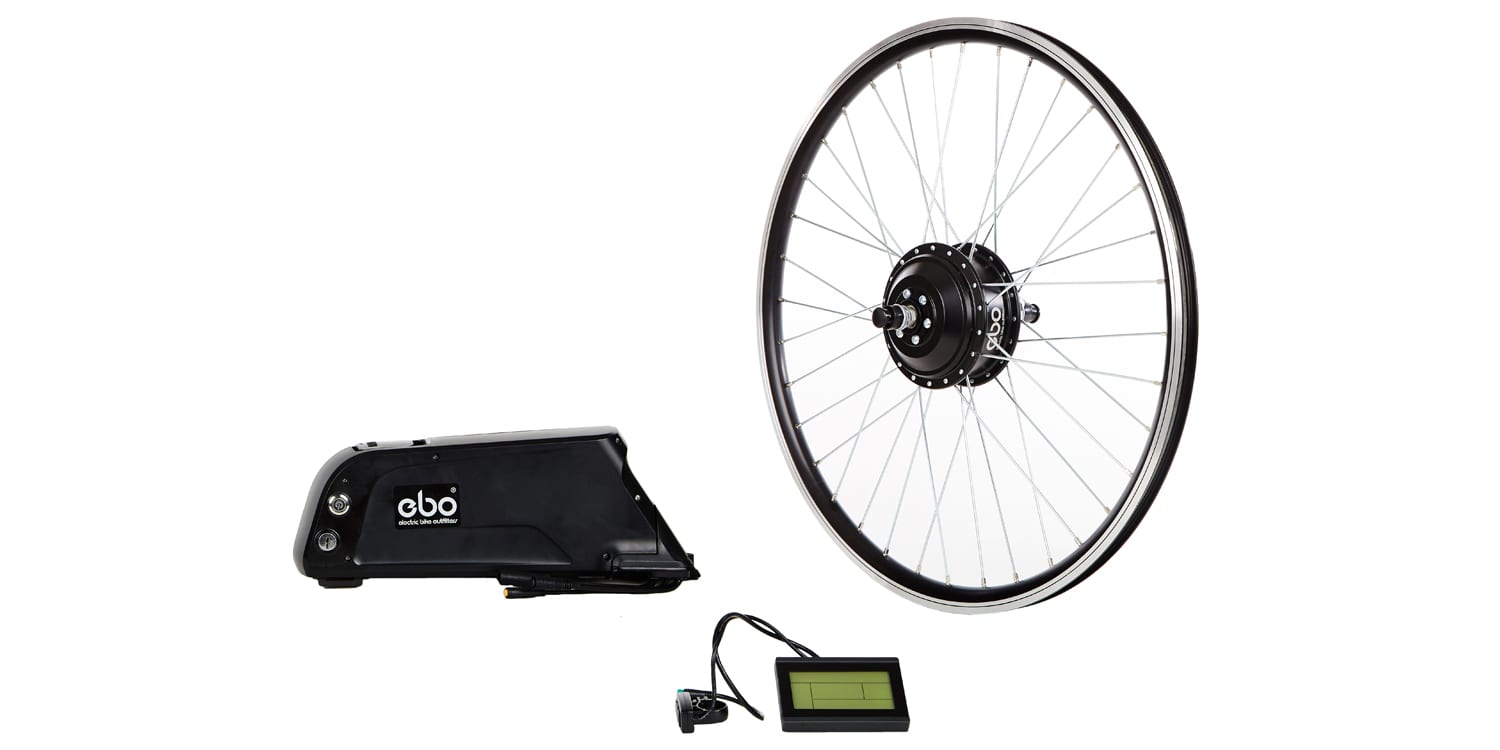
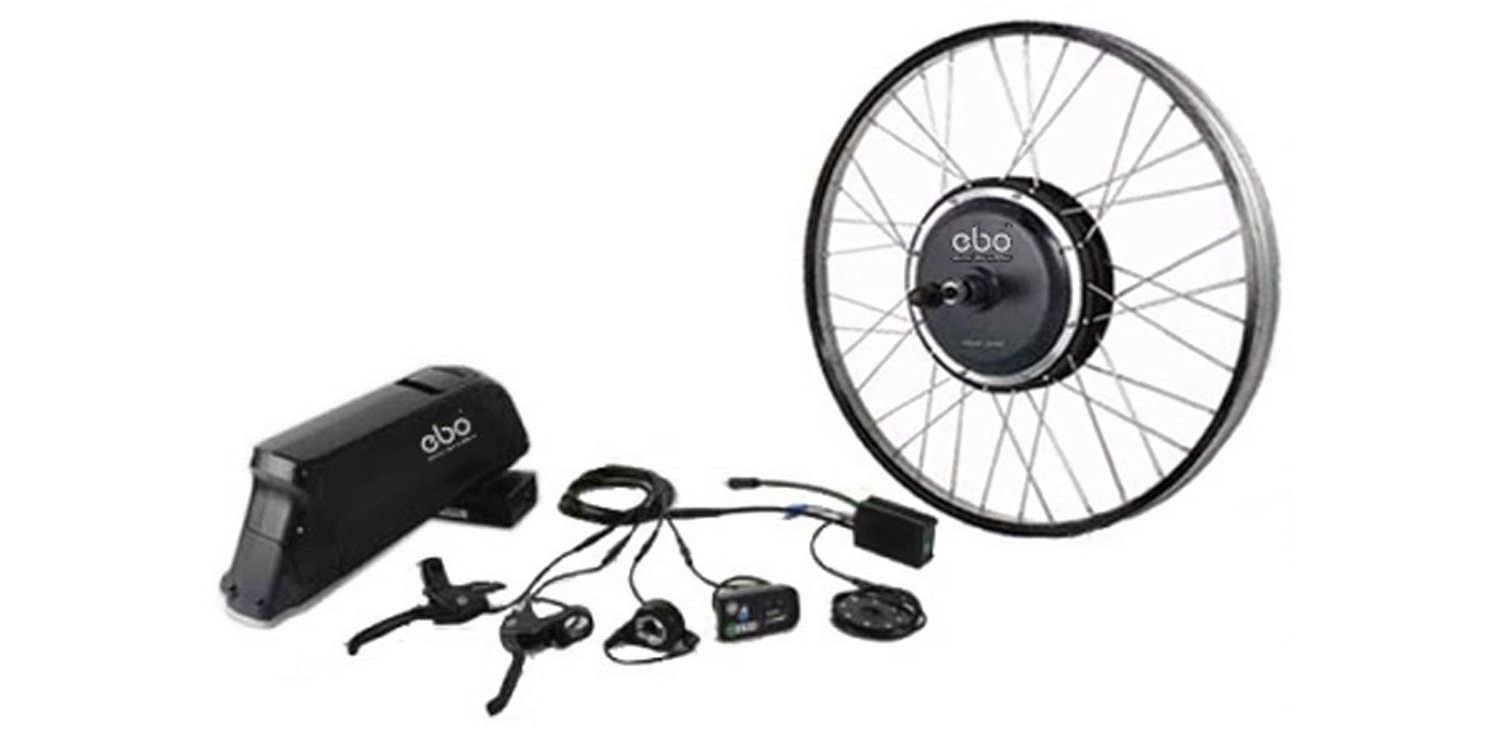
Reader Interactions